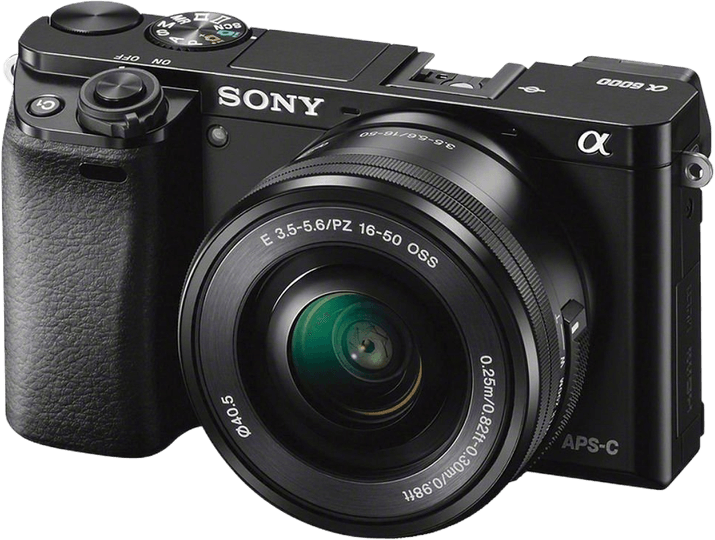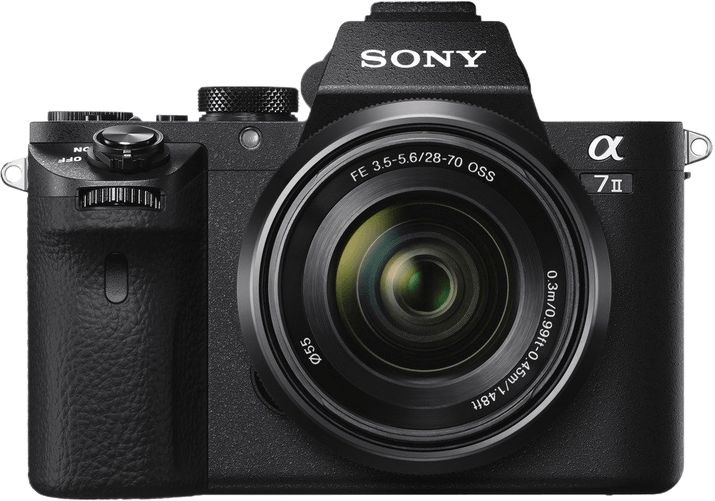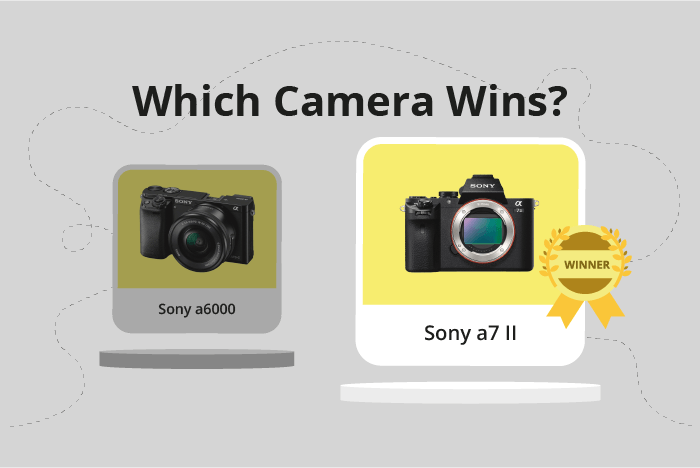Sony a6000 vs a7 II Comparison
Sony a6000

Sony a7 II

The Sony a7 II takes the lead with a score of 69/100, while the Sony a6000 trails behind with a score of 57/100. Both cameras share similarities as mirrorless cameras released in 2014. The Sony a7 II outshines the a6000 with its higher overall score, reflecting its better performance and features.
The Sony a6000, despite its lower score, has some advantages, including a lower launch price of $799 and a lighter weight of 344g. This makes it a more affordable and portable option for those who prioritize these factors.
On the other hand, the Sony a7 II justifies its higher price of $1600 and heavier weight of 599g with its superior features and performance, making it a better choice for users seeking top-quality results. The differences in scores and specifications show that the Sony a7 II is the clear winner in this comparison.
Sony a6000 vs a7 II Overview and Optics
The Sony a7 II outperforms the Sony a6000 in optics with a score of 78/100, while the a6000 scores 67/100. Both cameras share some common specifications, such as the sensor type (CMOS), processor (Bionz X), and lens mount (Sony E).
The superiority of the Sony a7 II lies in its full-frame sensor size, which provides better image quality and low-light performance compared to the APS-C sensor of the a6000. The a7 II also has a higher DXOMARK score for the sensor (90) than the a6000 (82), indicating improved overall image quality. Furthermore, the a7 II features image stabilization, which allows for sharper images in low-light conditions and during handheld shooting, while the a6000 does not have this feature.
On the other hand, the Sony a6000 has a slightly higher megapixel count (24.3) compared to the a7 II (24.2), but this difference is negligible and does not significantly impact image quality. The a6000 also boasts a faster shooting speed of 11 frames per second, as opposed to the a7 II’s 5 frames per second, making it more suitable for capturing fast-moving subjects.
In terms of optics, the Sony a7 II is the superior camera due to its full-frame sensor, higher DXOMARK score, and image stabilization. These features contribute to better image quality and low-light performance. However, the Sony a6000 has its advantages in shooting speed and a slightly higher megapixel count, making it a suitable option for those prioritizing action photography. Considering the optics alone, the Sony a7 II is the better choice for most users, while the a6000 may appeal to a specific niche of photographers.
Sony a6000 vs a7 II Video Performance
The Sony a6000 and Sony a7 II have identical video scores, with both cameras receiving a 56/100. Both cameras share common video specifications, including Full HD video resolution, max video dimensions of 1920 x 1080, and a max video frame rate of 60fps. Additionally, neither camera has built-in time-lapse functionality.
Despite having the same video score, each camera offers unique advantages in video capabilities. The Sony a6000 is a compact and lightweight camera, making it easier to handle and carry around for video shoots. This feature is particularly beneficial for vloggers and content creators who need a portable camera that delivers good video quality.
On the other hand, the Sony a7 II features a full-frame sensor, which provides better overall image quality, particularly in low light situations. The larger sensor enables the camera to capture more detail and produce higher quality video footage. This advantage makes the Sony a7 II a more suitable option for professional videographers and filmmakers who prioritize image quality over portability.
In terms of video capabilities, both cameras have their strengths and weaknesses. The Sony a6000 offers a more compact and lightweight design, making it a better choice for those who require a portable camera with good video quality. The Sony a7 II, with its full-frame sensor, provides superior image quality and is better suited for professional video projects. Ultimately, the choice between the two cameras will depend on the specific needs and priorities of the user.
Sony a6000 vs a7 II Features and Benefits
The Sony a7 II emerges as the winner in the features comparison, scoring 57 out of 100, while the Sony a6000 scores 41 out of 100. Both cameras share several specifications, including a 3-inch screen size, flip screen, lack of touchscreen, absence of GPS, presence of WIFI, and no bluetooth connectivity.
The Sony a7 II outperforms the Sony a6000 in screen resolution, boasting 1,230,000 dots as opposed to the a6000’s 921,600 dots. This higher resolution provides a clearer and sharper display, enhancing the user’s experience while framing shots and reviewing captured images.
On the other hand, the Sony a6000 does not have any standout features that make it superior to the Sony a7 II in this comparison. Both cameras possess the same core features, with the a7 II having the advantage of a higher screen resolution.
Taking these points into account, the Sony a7 II is the better camera in terms of features due to its higher screen resolution. The Sony a6000, while sharing many similarities with the a7 II, falls short in this aspect. The a7 II’s improved display quality leads to a more enjoyable and precise experience for photographers, making it the preferable choice between the two cameras.
Sony a6000 vs a7 II Storage and Battery
The Sony a6000 and Sony a7 II share similarities, such as having only one memory card slot and accepting SD, SDHC, SDXC, and Memory Stick Pro Duo cards. Additionally, both cameras use NP-FW50 batteries. Only the a7 II supports USB charging.
The Sony a6000 slightly outperforms the Sony a7 II in battery life, offering 360 shots compared to 350 shots. This difference is minor, but it could be important for photographers who need longer shooting sessions without changing batteries.
On the other hand, the Sony a7 II accepts Memory Stick Duo cards in addition to the Pro Duo and Pro-HG Duo cards, providing more compatibility with different memory card types. However, this advantage may not be significant for most users, as both cameras still support the more common SD and SDHC cards.
Considering these factors, the storage and battery performance of the Sony a6000 and Sony a7 II are quite similar. The a6000 has a slight edge in battery life, while the a7 II offers slightly more memory card and charging compatibility.
Sony a6000 vs a7 II – Our Verdict
Are you still undecided about which camera is right for you? Have a look at these popular comparisons that feature the Sony a6000 or the Sony a7 II:

